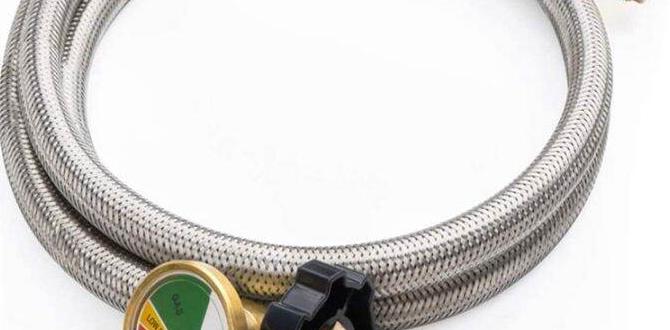Quick Summary: Adaptive equipment makes learning accessible for students with disabilities. These tools, from simple magnifiers to complex communication devices, help students participate fully in class by overcoming physical or learning barriers. Choosing the right equipment, often with a team, ensures every student has a fair chance to succeed in school.
Going to school should be exciting for every child, right? But sometimes, students with disabilities can face extra hurdles. These aren’t always easy to see, and they can make everyday tasks in the classroom feel like climbing a mountain. Maybe it’s tough to hold a pencil, read the board, or even follow along with a lecture. It can be frustrating for the student and for their family. The good news is that there’s a whole world of tools designed to level the playing field. These are called adaptive equipment, and they can make a huge difference, turning challenges into opportunities. We’ll show you what they are and how they can help your child shine.
What is Adaptive Equipment for Students with Disabilities?
Adaptive equipment, also known as assistive technology or assistive devices, refers to any item, piece of software, or product system that is used to increase, maintain, or improve the functional capabilities of individuals with disabilities. For students, this means equipment that helps them overcome challenges related to physical, sensory, cognitive, or learning disabilities, enabling them to participate more actively and effectively in their education. Essentially, it’s about removing barriers so that learning can happen.
Think of it like this: if a tool helps someone do something they couldn’t do easily before, it’s adaptive equipment. This can range from very simple items, like a pencil grip, to highly sophisticated computer systems. The goal is always to support the student’s independence and learning.
Why is Adaptive Equipment So Important in Schools?
The classroom can be a busy and demanding environment. For students with disabilities, the standard tools and methods used in education may not be suitable. Adaptive equipment bridges this gap, offering tailored solutions.
- Enhances Participation: It allows students to engage with lessons, participate in activities, and interact with peers, just like their classmates.
- Promotes Independence: Instead of relying on others for every task, students can use adaptive tools to perform tasks themselves, building confidence and self-esteem.
- Improves Learning Outcomes: By making information more accessible and tasks more manageable, adaptive equipment helps students learn more effectively and achieve their academic potential.
- Reduces Frustration: When a student struggles due to a disability, it can lead to frustration and disengagement. Adaptive tools can alleviate these struggles, making the learning process more positive.
- Supports Social Inclusion: Participating fully in classroom activities helps students feel like a part of the group, fostering social connections and a sense of belonging.
Types of Adaptive Equipment
Adaptive equipment covers a vast range of items, designed to meet diverse needs. They can generally be categorized by the type of disability they address.
For Physical Disabilities
Students with physical disabilities might have difficulty with movement, fine motor skills, or holding materials. Adaptive equipment can help with these challenges.
- Wheelchairs and Mobility Aids: For students with significant mobility impairments, wheelchairs, walkers, and adapted strollers provide essential mobility.
- Adapted Seating: Special chairs or cushions can provide proper support and posture correction, essential for students who have difficulty sitting or maintaining an upright position.
- Specialized Writing Utensils: Pencil grips, slant boards, and weighted pens can make writing easier for students with limited grip strength or tremors.
- Page Turners: These devices help students with limited hand dexterity turn pages in books or worksheets.
- Adapted Computer Keyboards and Mice: Larger keys, alternative key layouts, or trackballs can make computer use more accessible.
- Speech-Generating Devices (SGDs): For students who cannot speak, SGDs allow them to communicate by selecting words or phrases that are then spoken aloud by the device, or displayed as text. An example is the Tobii Dynavox devices, which often use eye-gaze technology. Visit Tobii Dynavox for examples.
For Visual Impairments
Students with low vision or blindness need tools that make visual information accessible.
- Magnifiers: Handheld, stand, or electronic magnifiers help students read text and see details on worksheets or screens.
- Braille Translators and Printers: For emerging braille readers, or to produce braille materials.
- Screen Readers: Software that reads aloud the text displayed on a computer screen, crucial for students who are blind. Popular options include JAWS (Job Access With Speech) and NVDA (NonVisual Desktop Access).
- Telescopes and Monoculars: These can help students see distant objects, like the whiteboard or presenter, more clearly.
- Tactile Graphics: Raised-line drawings and maps that students can feel, providing visual information through touch.
- Large Print Books and Materials: Standard print can be difficult to read; large print versions are often available or can be created.
For Hearing Impairments
Students who are deaf or hard of hearing require ways to access auditory information.
- Hearing Aids and Cochlear Implants: These are personal devices that amplify sound or directly stimulate the auditory nerve.
- FM Systems: A teacher or speaker wears a microphone, and the sound is transmitted wirelessly to the student’s hearing aids or cochlear implants as a focused signal, reducing background noise.
- Visual Alert Systems: Flashing lights or vibrating devices signal important sounds like fire alarms or doorbells.
- Captioned Videos and Real-time Captioning: Written text of spoken words displayed on screen during videos or live presentations.
- Sign Language Interpreters: Provide real-time translation of spoken language into sign language.
For Learning Disabilities and Cognitive Impairments
Students with dyslexia, ADHD, autism, or other cognitive challenges may benefit from tools that help with focus, organization, reading, writing, and comprehension.
Reading and Writing Support:
- Text-to-Speech Software: Reads digital text aloud, helping with reading comprehension for students with dyslexia. Many modern operating systems and word processors have this built-in, or standalone options like Read&Write are widely used.
- Speech-to-Text Software (Dictation): Allows students to speak their thoughts and have them transcribed into text, aiding those who struggle with the physical act of writing or organizing their thoughts on paper.
- Graphic Organizers: Software or templates that help students visually map out ideas, plan essays, or break down complex tasks.
- Word Prediction Software: Suggests words as a student types, reducing the effort needed and helping with spelling.
Organization and Focus:
- Timers and Visual Schedules: Help students manage time, understand routines, and transition between activities, especially beneficial for students with ADHD or autism.
- Noise-Canceling Headphones: Reduce distractions in noisy environments, promoting focus.
- Digital Planners and Apps: Tools for managing assignments, deadlines, and notes.
Cognitive Support:
- Memory Aids: Digital recorders, note-taking apps with reminders, or even simple visual cue cards can help with remembering information.
- Simplified Interfaces: Some software or devices offer simplified menus and navigation for students who get overwhelmed by complex interfaces.
For Communication Disorders
Students with speech and language impairments may need alternative ways to express themselves.
- Augmentative and Alternative Communication (AAC) Devices: This is a broad category that includes everything from simple picture boards to sophisticated computer systems.
- Picture Exchange Communication System (PECS): A system where individuals exchange pictures for desired items or activities.
- Communication Boards/Books: Physical boards or books with pictures, symbols, or words that a student can point to.
- Speech-Generating Devices (SGDs): As mentioned earlier, these electronic devices can produce synthesized or recorded speech. Devices like the Proloquo2Go app for iPads are popular examples.
- Voice Amplifiers: For students with very soft voices.
How to Choose and Implement Adaptive Equipment
Selecting the right adaptive equipment is not a one-size-fits-all process. It requires careful consideration and collaboration.
The Assessment Process
Before any equipment is chosen, a thorough assessment is crucial. This typically involves:
- Observation: Teachers, therapists, and parents observe the student in various school settings to identify specific challenges and strengths.
- Needs Identification: Determining what tasks the student struggles with and what goals they need to achieve.
- Trial and Error: Trying out different types of equipment to see what works best for the individual student. Factors like ease of use, comfort, and effectiveness are evaluated.
- Professional Input: This process often involves a team of professionals, including special education teachers, occupational therapists (OTs), physical therapists (PTs), speech-language pathologists (SLPs), and assistive technology specialists.
It’s important to remember that adaptive equipment is most effective when it’s tailored to the individual student’s unique needs, abilities, and learning style. Resources like the Center for Parent Information and Resources offer guidance on navigating these processes for families.
Involving the Student
Whenever possible, the student should be involved in the selection process. Their preferences, comfort levels, and opinions are vital. If a student likes using a particular device, they are far more likely to use it consistently and effectively. Empowering students by giving them a voice in their learning tools can significantly boost their engagement and motivation.
Training and Support
Simply providing equipment isn’t enough. Everyone involved needs to know how to use it:
- Student Training: The student needs clear, ongoing instruction on how to operate and integrate the equipment into their daily school activities.
- Teacher and Staff Training: Teachers and aides must understand the purpose of the equipment, how to operate it, and how to support the student’s use of it. Proper training ensures that the equipment is used to its full potential and doesn’t become a barrier itself.
- Parent/Guardian Support: Parents often need guidance on how to support their child’s use of adaptive equipment at home, if applicable, and how to communicate with the school about its effectiveness.
Integration into the Classroom
Adaptive equipment should be seamlessly integrated into the regular classroom environment. This means:
- Accessibility: Ensuring the equipment is readily available when needed.
- Consistency: Using the equipment consistently across different tasks and subjects.
- Flexibility: Being prepared to adapt the use of equipment as the student’s needs evolve.
- Inclusivity: Fostering an environment where using adaptive equipment is seen as a normal and helpful part of learning, not something to be singled out for.
Funding and Obtaining Adaptive Equipment
The cost of adaptive equipment can vary widely, from a few dollars for a pencil grip to thousands for high-tech communication devices. Finding ways to fund these essential tools is a common concern for families and schools.
School District Responsibilities
Under laws like the Individuals with Disabilities Education Act (IDEA) in the United States, public schools are required to provide Free Appropriate Public Education (FAPE) to eligible students with disabilities. This includes providing necessary special education and related services, which can encompass adaptive equipment. Schools often have a budget allocated for assistive technology, and a team (often called an IEP team or AT team) determines what is needed.
Key points:
- If your child has an Individualized Education Program (IEP) or a 504 plan, adaptive equipment should be considered as part of their accommodations.
- Contact your child’s school to request an assistive technology evaluation.
- Advocate for your child’s needs by attending IEP meetings and providing relevant documentation.
Other Funding Sources
Besides school funding, other avenues may exist:
- Insurance: Some adaptive equipment might be covered by private health insurance or government programs like Medicaid, especially if prescribed by a doctor.
- Non-Profit Organizations: Many organizations offer grants, loans, or refurbished equipment for individuals with specific disabilities.
- Government Programs: State vocational rehabilitation agencies or disability services offices may offer assistance.
- Crowdfunding: Platforms like GoFundMe can be used by families to raise funds for specialized equipment.
It’s important to research and explore all available options. Navigating these systems can be complex, but resources are available to help families.
Maintaining and Upgrading Adaptive Equipment
Once acquired, the equipment needs to be maintained to ensure it continues to function properly and meet the student’s needs.
Regular Maintenance Checks
Simple routines can keep equipment in good working order:
- Cleaning: Regularly clean devices, especially those used daily, according to manufacturer instructions.
- Battery Checks: For electronic devices, ensure batteries are charged and functioning correctly.
- Software Updates: Keep any software associated with the equipment up to date.
- Physical Inspections: Check for wear and tear, loose parts, or damage.
When to Consider Upgrades
Needs change, and technology evolves:
- Student Growth and Changing Needs: As a student grows or their abilities develop, their current equipment might become less effective or suitable.
- Technological Advancements: Newer versions of equipment may offer improved features, better efficiency, or greater ease of use.
- Malfunction or Obsolescence: If a device is no longer functioning correctly and cannot be repaired, or if it becomes obsolete and unsupported, an upgrade is necessary.
Regular review of the student’s needs and the effectiveness of their current equipment (often as part of annual IEP meetings) is key to ensuring they always have the best tools available to support their education.
Case Study Snapshot
Let’s look at a quick example. Meet Maya, a second-grader with dyslexia. Reading was a huge struggle, making her feel left behind. Her school team decided to try the Text-to-Speech feature built into her school tablet, along with a reading pen that could scan and read words aloud. Initially, Maya was hesitant, but after a few weeks of practice with her teacher, she started using the tools for her reading assignments. She found she could keep up with her classmates, understand the stories, and even enjoy reading now. The frustration melted away, replaced by growing confidence. This simple use of adaptive technology opened up a world of learning for Maya.
Frequently Asked Questions (FAQs)
What is the main goal of adaptive equipment?
The main goal is to help students with disabilities overcome barriers and access education more fully, promoting independence, participation, and learning.
Who decides which adaptive equipment a student needs?
Typically, a team including the student, parents, teachers, and specialists like occupational therapists or assistive technology coordinators makes these decisions based on assessments of the student’s needs and goals.
How can parents advocate for adaptive equipment for their child?
Parents can advocate by attending IEP meetings, providing input on their child’s needs, researching available equipment, and working collaboratively with the school team.
Is adaptive equipment only for severe disabilities?
No, adaptive equipment can range from simple tools like pencil grips to complex devices. It’s designed to support a wide spectrum of needs, including mild learning differences, sensory issues, and physical challenges.
What is the difference between adaptive equipment and accommodations?
Adaptive equipment refers to the actual tools or devices used. Accommodations are the adjustments made to the learning environment or tasks to help a student succeed (e.g., extended time, preferential seating), which may or may not involve adaptive equipment.
How do schools fund adaptive equipment?
Schools often use federal and state funding (like IDEA), district budgets dedicated to special education or assistive technology, and sometimes grants to acquire adaptive equipment.
Can adaptive equipment be used at home?
Yes, if the equipment is necessary for the student to benefit from their education, and if it’s part of their IEP or 504 plan, schools may provide or recommend equipment for home use.
Conclusion
Adaptive equipment is a powerful ally for students with disabilities, unlocking potential and paving the way for academic success and personal growth. From specialized software that reads text aloud to simple tools that make writing easier, these innovations are all about creating an inclusive and effective learning environment for everyone. By understanding the çeşit çeşit available options and working collaboratively as a team—students, parents, educators, and therapists—we can ensure that every child has the support they need to thrive. Investing in the right adaptive equipment is an investment in a student’s future, helping them build confidence, independence, and a lifelong love for learning.



